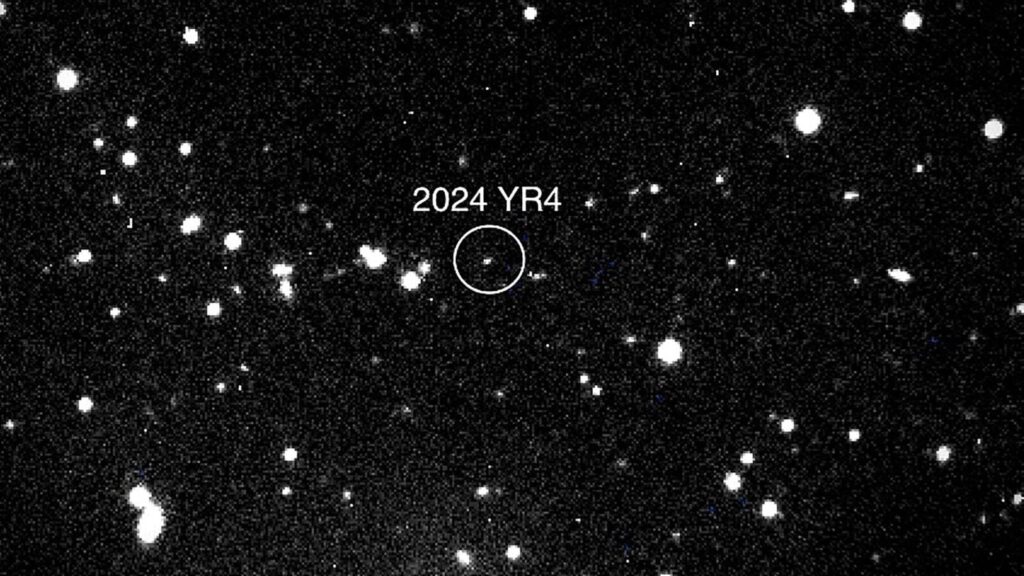Asteroid 2024 YR4, a newly discovered near-Earth object, has caught the attention of scientists due to its size and potential impact risk. Measuring between 40 to 90 meters (130 to 300 feet) wide, it is large enough to cause significant localized damage if it were to collide with Earth. While the chances of impact on December 22, 2032, remain low, the asteroid has surpassed the 1% probability threshold—an uncommon occurrence for objects of this size—prompting formal notifications to planetary defense agencies. NASA continues to track 2024 YR4 closely, as further observations could either rule out the threat or refine its impact probability.
The asteroid was discovered on December 27, 2024, by the Asteroid Terrestrial-impact Last Alert System (ATLAS) in Chile, as per CNEOS analysis of near-Earth asteroid, Jet Propulsion Laboratory stated.
The International Asteroid Warning Network (IAWN) has been alerted, along with U.S. government agencies and the United Nations Office of Outer Space Affairs, NASA stated.
Current risk assessment
According to NASA’s Jet Propulsion Laboratory (JPL), 2024 YR4 is currently classified as Torino Scale 3, meaning it has a small chance of impact but is large enough to cause localized damage if it were to strike. It is uncommon for an asteroid of this size to reach Torino Scale 3, as most objects with impact probabilities greater than 1% are significantly smaller and burn up in the atmosphere.
Center for NEO Studies (CNEOS), as reported by Jet Propulsion Laboratory (JPL), currently classifies 2024 YR4 as a Torino Scale 3 asteroid, indicating a small chance of impact but a size large enough to cause localized damage if a collision occurs. It is rare for an asteroid of this size to reach Torino Scale 3, as most objects with impact probabilities above 1% are much smaller and typically disintegrate in the atmosphere.
NASA scientists stress that impact predictions change daily as new data refines the asteroid’s trajectory. Past NEOs with initially concerning probabilities have often been ruled out as threats once additional observations improved their orbital models.
Projected path and impact possibility
As of January 31, 2025, 2024 YR4 is 48 million kilometers (30 million miles) from Earth and moving away. The asteroid is expected to return to Earth’s vicinity in 2028, but NASA confirms there is no risk of impact during that approach.
If 2024 YR4 were to impact Earth in 2032, the likely impact zone would be somewhere along a risk corridor spanning: The eastern Pacific Ocean, Northern South America, The Atlantic Ocean, Africa, The Arabian Sea, South Asia.
NASA estimates that the asteroid would enter Earth’s atmosphere at approximately 17 km/s (38,000 mph), which could cause significant regional effects depending on the impact location.
Ongoing observations and future predictions
NASA’s Sentry impact monitoring system has been tracking 2024 YR4 since its discovery. It was first reported to the Minor Planet Center (MPC) on January 27, 2025. Several observatories are actively monitoring the asteroid’s movements. Observations will continue until April 2025, when it becomes too faint for ground-based telescopes to track. However, space-based infrared telescopes could provide further data beyond that period.
Continuous risk assessment
NASA’s planetary defense experts will continue to update 2024 YR4’s risk assessment as new data emerges. The Sentry impact monitoring system will reassess the trajectory and provide updated impact probabilities over time.
While the likelihood of impact remains low, NASA’s ongoing observations and international collaboration ensure that any potential threat will be well-monitored and, if necessary, met with mitigation strategies.
Catch all the Business News, Market News, Breaking News Events and Latest News Updates on Live Mint. Download The Mint News App to get Daily Market Updates.
MoreLess

